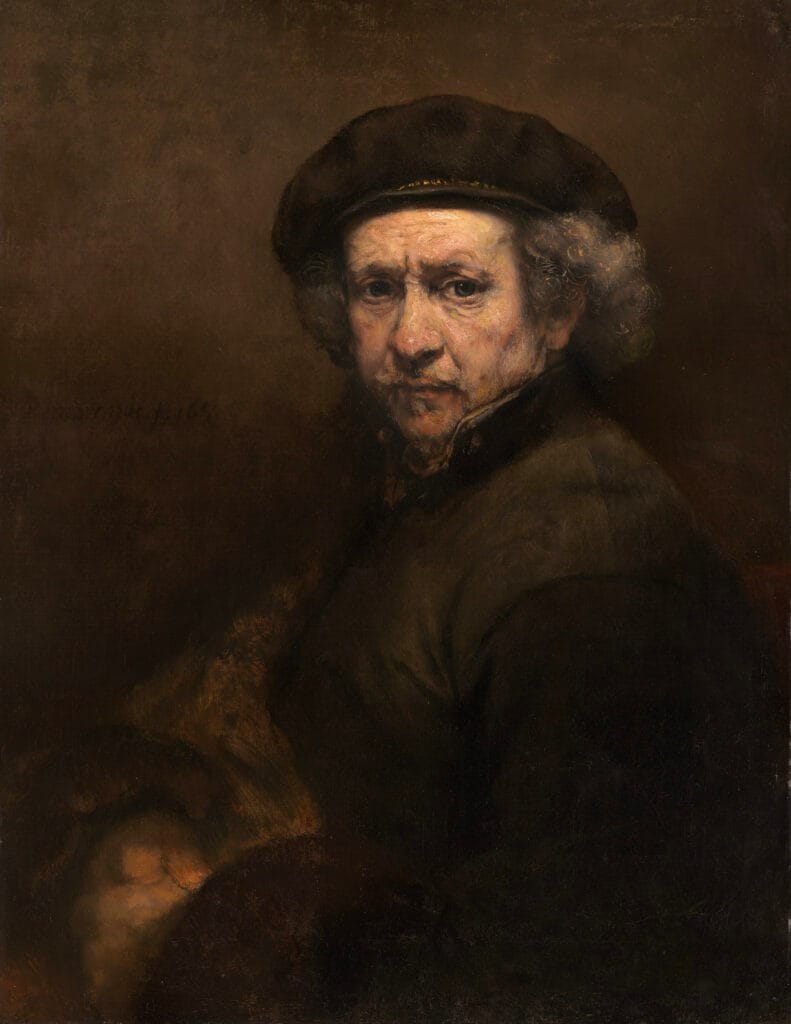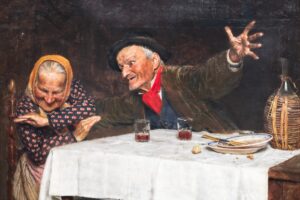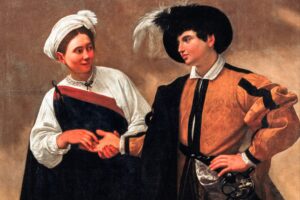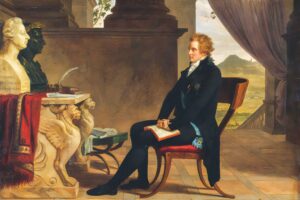The Storm on the Sea of Galilee – Rembrandt van Rijn, 1633
Waves rise like walls, tearing sky from sea, as a small fishing boat fights to survive the chaos. Amid wind, water, and panic, twelve men struggle while one remains still. In The Storm on the Sea of Galilee, Rembrandt does not merely illustrate a biblical miracle—he drops us into its center. Here, terror howls, and faith hangs by a thread.
The Scene Before Us
At the height of the storm, the boat creaks and tilts, its sail slashing through the sky. Water floods the deck. Each figure clings, pulls, cries, or prays. Every posture is different—some wrestle with ropes, one vomits overboard, another kneels, clutches, begs.
Yet at the stern, calm amidst the chaos, sits Christ.
He is quiet. Others shout. He looks at his disciples as they scream, “Do you not care that we perish?” But he does not match their fear. He answers not with panic—but with peace.
Rembrandt’s composition is dizzying: diagonals of sail and mast crash into one another, casting light and dark in violent contrast. The water feels alive—angry, consuming, real. This is not a calm parable—it is a crisis. And we are caught in it.
The Deeper Meaning
The storm is not just on the sea—it’s in the soul. Each figure reveals a different face of fear, doubt, and despair. Faith, here, is not serene. It is desperate. It questions. It forgets.
And yet, at the heart of the tempest, Christ remains. He does not deny the storm, but he commands it. And in doing so, he commands the hearts of those who follow—though trembling, though imperfect.
Rembrandt, in his own life, knew storms well. Loss, failure, exile—all swept through his years. It’s no wonder that this single seascape he ever painted is not romantic, but raw. It is not distant, but painfully human.
One figure, gripping a rope and staring directly at us, is believed to be a self-portrait. Perhaps Rembrandt painted himself as one who clings but still looks outward—seeking something, anything, to hold onto.
A Moment Caught in Time
This is not the moment after the miracle. The sea is still wild. The fear still real. But even in this darkness, a sliver of light breaks through.
It is the moment before belief returns—the moment when faith is not yet found, but desperately needed.
And maybe that’s why the painting endures. Because we’ve all known such storms—when the world tilts, the sky falls, and hope seems lost. And we too must ask, “Do you not care?” And wait for the answer, still and calm.
About Artist

Rembrandt Harmenszoon van Rijn (1606–1669) was a Dutch Golden Age painter and printmaker widely considered one of the greatest visual artists in history. Unlike many of his contemporaries, he never traveled to Italy but was nonetheless deeply influenced by the Italian Baroque, particularly the work of Caravaggio. Rembrandt was a master of a wide range of subjects, including portraits, landscapes, and biblical and historical scenes. His later life was marked by financial hardship, but his artistic output remained at a masterful level, with his later works showing an even greater emotional and psychological depth.
Artistic Style and Techniques
Rembrandt’s style is defined by his profound humanism and his masterful command of light and shadow, a technique known as chiaroscuro. He used this dramatic contrast to create a powerful sense of emotion and to draw the viewer’s eye to the most important parts of the canvas, such as the face or hands of a subject. His technique became increasingly loose and expressive over time; his late works are known for their impasto—thick, textured layers of paint that give his canvases a sculptural quality. This expressive brushwork and his ability to capture the inner life and spirit of his subjects set him apart from his peers.
Notable Works
Rembrandt’s prolific career produced an incredible number of masterpieces.
- The Night Watch (1642): A monumental group portrait of a civic militia company, this painting broke with tradition by depicting the subjects in a dynamic, action-filled scene rather than a static, formal pose.
- The Anatomy Lesson of Dr. Nicolaes Tulp (1632): One of his early masterpieces, this painting captures a public dissection with a vivid sense of realism and psychological intensity, demonstrating his genius for group portraiture.
- The Return of the Prodigal Son (c. 1669): A profoundly moving late work that is celebrated for its deep emotional and spiritual resonance, using light and color to convey a sense of forgiveness and love.
- The Storm on the Sea of Galilee (1633): Rembrandt’s only known seascape, this painting is a thrilling depiction of the biblical miracle. It captures the chaotic and terrifying scene of a boat being tossed by a ferocious storm. The dramatic diagonal of the boat and the masterful use of tenebrism—the stark contrast between the stormy gloom and the flash of light on the waves and the terrified faces of the disciples—perfectly embodies the drama of the Baroque. One of the figures in the boat, looking out at the viewer, is widely believed to be a self-portrait of the artist himself. Unfortunately, this painting was stolen in a major art heist in 1990 and its whereabouts remain unknown.



